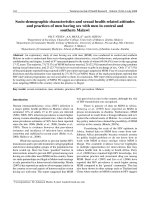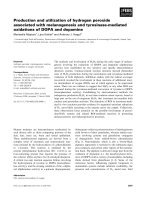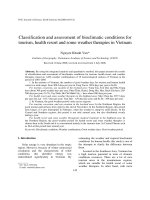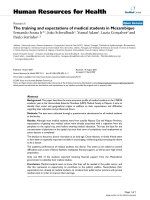TRAINING AND ASSESSMENT OF HAND EYE COORDINATION WITH ELECTROENCEPHALOGRAPHY
Bạn đang xem bản rút gọn của tài liệu. Xem và tải ngay bản đầy đủ của tài liệu tại đây (5.35 MB, 175 trang )
TRAINING AND ASSESSMENT OF HAND-EYE
COORDINATION WITH
ELECTROENCEPHALOGRAPHY
LEE CHUN SIONG
(B.Eng.(Hons.), NUS)
A THESIS SUBMITTED
FOR THE DEGREE OF DOCTOR OF PHILOSOPHY
DEPARTMENT OF MECHANICAL ENGINEERING
NATIONAL UNIVERSITY OF SINGAPORE
2015
II
DECLARATION
I hereby declare that this thesis is my original work and it has been written by me
in its entirety. I have duly acknowledged all the sources of information which have
been used in the thesis.
This thesis has also not been submitted for any degree in any university
previously.
Lee Chun Siong
14 Jan 2015
III
Acknowledgments
First of all, I would like to express my deepest gratitude for my supervisor,
Associate Prof Chui Chee Kong, for his guidance over the years. This thesis would
not be possible if not for his constant guidance and encouragement.
I would like to thank my family, friends and colleagues at NUS for helping me
through the period of my studies and encouraging me throughout this arduous
journey.
I would also like to thank the various collaborators and mentors who have also
helped me to accomplish this work:
Associate Prof Stephen Chang (NUH)
Dr Guan Cuntai (AStar I2R)
Mr Wang Chuan Chu (AStar I2R)
Dr Tan Bhing Leet (IMH)
Dr Joseph Leong (IMH)
Dr Eu Pui Wai (IMH)
IV
Summary
Hand-eye coordination (HEC) is a complex system of perceptual processing of
visual information, proprioceptive feedback of our hands and arms and the cognitive
controller that manages these sensory inputs and executive motion. It is a natural
function taken for granted in the simple common tasks in everyday life. However, in
some people such as mentally ill patients, their hand-eye coordination may become
impaired and require exhaustive rehabilitative treatments. At the other end of the
spectrum, professionals such as athletes and surgeons require excellent HEC to
function.
The objective of this thesis is to investigate the visual, motor and neural aspects
of HEC through neural and motor performance analysis of subjects performing visual
cue driven HEC tasks such as pointing and tracing in order to examine a person’s
hand eye coordination capability thereby leading to methods for more effective
assessment and training. This research approaches each aspect of HEC and develops
appropriate simulation games to study the hand eye coordination skills of subjects.
Specific investigations include identifying pertinent Electroencephalography (EEG)
markers correlating to motor skill mastery, analysing and correlating motor
performance with neural activity.
The effect of visual cues influencing HEC was studied upon. Visual cues provide
significant perceptual information that can affect performance. In some scenarios
such as surgical endoscopy, some cues are lost or diminished, leading to reduced
HEC ability and diminished motor performance. In our study, we investigated the
influence of attenuating and augmenting various visual cues such as dynamic depth
shadowing to improve HEC capability, reducing execution time and number of errors.
The effect of robotic haptic guidance on motor skill mastery of two HEC tasks
through a robotic manipulator was also investigated. Through two separate tasks, one
V
designed for testing accuracy of motion and another designed for testing consistency
in motion, detailed motion analysis breakdown in factors such as cumulative
trajectory error and cumulative joint angle motion show that robotic guidance
improves motor skill mastery more than autonomous practice. Haptic guidance also
elicited a larger change in neural signal complexity in the subjects.
Conventional physical motor task performance metrics, when insufficient in
differentiating the overall performance, can be augmented with neural analysis.
Utilizing non-invasive EEG readings, we compared task performance against EEG
readings to identify possible neural markers for gauging mental activity pertinent to
motor skill mastery of a simple folding task. Through power spectrum and signal
complexity analysis, results identify signal complexity values and activity in the theta
and low alpha frequency band in the central, occipital and parietal regions as suitable
neural markers.
Further experiments with a rapid-fire pointing task within an interactive game on
a touch-screen panel demonstrated the correlation between task performance learning
curves with neural activity and the effect of colour in the visual cues presented to the
subjects. Epoched extraction of consecutive event related EEG data enabled neural
analysis at shorter time scales, revealing significant differences in intra-task
waveforms for different scenarios.
VI
Table of Contents
Acknowledgments III
Summary IV
Table of Contents VI
Author’s Publications X
List of Tables XI
List of Figures XII
List of Abbreviations XVII
1 Introduction 1
1.1 Background and Motivations 1
1.2 Objectives and Scope 4
1.3 Contributions 6
2 Literature Review 8
2.1 Monitoring 8
2.1.1 Eye tracking 8
2.1.2 Motion tracking 11
2.1.3 Neural tracking 16
2.2 Assessment 19
2.2.1 Standard motor skill tests 19
2.2.2 Arbitrary testing 20
2.2.3 Integrated measurement system 20
2.3 Modelling and analysis 21
2.3.1 Descriptive models 23
VII
2.3.2 Complete models 25
2.3.3 Biological model 27
2.3.4 Internal models 28
2.4 HEC measurement and monitoring 33
2.5 Methods and Materials of EEG Analysis 34
2.5.1 EEG fundamentals 36
2.5.2 EEG for motor learning of HEC tasks 40
3 Integrated Framework for Hand-Eye Coordination Training 43
3.1 Conceptual framework 43
3.2 Motor performance analysis 46
3.3 Cognitive cost and cognitive capacity modelling 47
4 Experiment - Depth Perception and Colour Cues 51
4.1 Background 51
4.2 Materials and Methods 55
4.2.1 Experiment 1 55
4.2.2 Experiment 2 61
4.3 Results 63
4.3.1 Experiment 1 63
4.3.2 Experiment 2 64
4.4 Discussion 65
4.4.1 Experiment 1 65
4.4.2 Experiment 2 66
4.5 Summary 67
VIII
5 Experiment - Folding task with visual cue 71
5.1 Background 71
5.2 Materials and Methods 74
5.2.1 Subjects and Experimental Protocol 74
5.2.2 Equipment 74
5.2.3 EEG processing 76
5.3 Results 77
5.4 Discussion 80
5.4.1 LZC distribution 80
5.4.2 Spectral Analysis 86
5.5 Summary 88
6 Experiment - Tracing and pointing task with robotic guidance 90
6.1 Background 90
6.2 Materials and Methods 94
6.2.1 Experimental Setup 94
6.2.2 Laparoscopic tasks 94
6.2.3 Experimental Protocol 96
6.3 Results 97
6.4 Discussion 100
6.4.1 Circular Tracing task Discussion 100
6.4.2 Pointing task 103
6.5 Summary 107
7 Experiment - Sequential Pointing task 109
IX
7.1 Background 109
7.2 Materials and Methods 111
7.2.1 Experimental setup 111
7.2.2 Experimental task 112
7.2.3 Experimental Protocol 116
7.3 Results 117
7.4 Discussion 127
7.5 Summary 129
8 Conclusions 132
9 Future Work 136
10 BIBLIOGRAPHY 138
APPENDIX: EEG Analysis results from the sequential pointing experiment 151
X
Author’s Publications
Book Chapters
C.S. Lee and C.K. Chui. “Training and Measuring the Hand–Eye Coordination
Capability of Mentally Ill Patients” in Advances in Therapeutic Engineering.
CRC Press ISBN 9781439871737. pp. 45-82, 2012.
C. S. Lee, C. K. Chui, C. T. Guan, P. W. Eu, B. L. Tan, and J. Leong,
“Integrating EEG Modality in Serious Games for Rehabilitation of Mental
Patients,” in Simulations, Serious Games And Their Applications, Y. Cai and S.
L. Goei, Eds. Singapore, pp. 51–68, 2014.
Article in Journal
C.S. Lee and C.K. Chui, “EEG Analysis of Hand-eye Coordination with
Simulation Games”, Simulation & Gaming (submitted)
C.S. Lee, C.K. Chui, and S. K. Y. Chang. “Influence of Dynamic Shadowing on
2D and 3D Laparoscopic Visualization Under Visible Light and Infrared Light”,
Journal of Laparoendoscopic & Advanced Surgical Techniques A, vol. 23, pp.
561-569, 2013.
S. K. Y. Chang, C. S. Lee, W. W. Hlaing, and C. K. Chui, "Vascularised porcine
liver model for surgical training", Medical Education, vol. 45, pp. 520, 2011.
Conference Paper
C. S. Lee, L. Yang, T. Yang, C. K. Chui, J. Liu, W. Huang, Y. Su, and S. K. Y.
Chang, "Designing an active motor skill learning platform with a robot-assisted
laparoscopic trainer," in Engineering in Medicine and Biology Society, EMBC,
pp. 4534-4537, 2011.
XI
List of Tables
Table 2.1: EEG Frequency Bands 39
Table 4.1: Subject demographics for the first experiment 56
Table 4.2: Subject demographics for the second experiment 61
Table 4.3: Averaged results for experiment 1 69
Table 4.4: Averaged results for experiment 2 70
Table 6.1: Subject performance in the circle tracing task 97
Table 6.2: Percentile improvement in performance of the control group 99
Table 6.3: Percentile improvement in performance of the haptic guidance group 99
XII
List of Figures
Figure 1.1: Aspects of Hand-Eye Coordination. 2
Figure 2.1: Multimodal HEC measurement system. 14
Figure 2.2: Photographs of a medical student performing a Pick and Place task 15
Figure 2.3: Sample snapshot showing 6 channels of raw EEG reading 18
Figure 2.4: Integrated system of sensors for HEC measurement. 21
Figure 2.5: Sample snapshot of a raw EEG reading with eye blinking artefact. 37
Figure 2.6: Sample snapshot of a raw EEG reading. 37
Figure 2.7: Spatial potential mapping of EEG signals with isopotential contour lines.
38
Figure 3.1: Biological Model with Sensory Feedback. 44
Figure 3.2: Biological model with integrated forward and inverse models. 49
Figure 3.3: Biological model with integrated forward and inverse models and
neurofeedback. 50
Figure 4.1: Overview of the laparoscopic box trainer. 57
Figure 4.2: Overhead light-emitting diode probe. 57
Figure 4.3: Light-emitting diode probe mounted on a laparoscopic grasper. 58
Figure 4.4: Task 1: Threading a wooden stick through the perforated Lego brick. 59
Figure 4.5: Task 2: pushing a Lego brick horizontally across the workspace. 60
Figure 4.6: Task 3: Picking and placing the randomly positioned sponge cubes. 60
Figure 4.7: Performing task 3 under infrared illumination. 62
Figure 4.8: The colour differences of the same Lego brick under (left) infrared and
(right) visible light. 67
Figure 5.1: Topographic plot of the EEG electrodes recorded in accordance to the
International 10-20 system of EEG electrode placement and labelling. 75
Figure 5.2: Sequential screenshots of the origami folding instructions shown to the
subjects. 75
XIII
Figure 5.3: Screenshot of Subject 1 performing the folding task. 76
Figure 5.4: Time taken for each origami box folding trial of all 6 subjects 77
Figure 5.5: Lempel-Ziv Complexity values for all 19 EEG channels at all 5 trials of
Subject 1. 78
Figure 5.6: Lempel-Ziv Complexity values for all 19 EEG channels at all 5 trials of
Subject 2. 78
Figure 5.7: Lempel-Ziv Complexity values for all 19 EEG channels at all 5 trials of
Subject 3. 78
Figure 5.8: Lempel-Ziv Complexity values for all 19 EEG channels at all 5 trials of
Subject 4. 79
Figure 5.9: Lempel-Ziv Complexity values for all 19 EEG channels at all 5 trials of
Subject 5. 79
Figure 5.10: Lempel-Ziv Complexity values for all 19 EEG channels at all 5 trials of
Subject 6. 79
Figure 5.11: Averaged Lempel-Ziv Complexity distribution of all EEG channels for
all 6 subjects. 80
Figure 5.12 (a-e): Channel spectra and topographic maps of Subject 5 for all 5 trials.
81
Figure 5.13 (a-e): Channel spectra and topographic maps of Subject 6 for all 5 trials.
82
Figure 5.14(a-i): Individual frequency spectrums of channel C3, C4, CZ, O1, OZ,
O2, P3, PZ and P4 for Subject 5. 84
Figure 5.15: (a-i) Individual frequency spectrums of channel C3, C4, CZ, O1, OZ,
O2, P3, PZ and P4 for Subject 6. 85
Figure 6.1: Endoscopic view of the circular tracing task. 95
Figure 6.2: Endoscopic view of the pointing task. 96
Figure 6.3: Example of the circle tracing trajectory by (a) Subject 8 and (b) Subject
11. 98
XIV
Figure 6.4: Example of the conical workspace of the pointing task trajectory recorded
by Subject 1. 99
Figure 6.5: Circle task – Control Group (best vs. worst performer). 101
Figure 6.6: Circle task – Haptic Guided Group (best vs. worst performer). 101
Figure 6.7: Trial Averaged LZC values for Control Group - Circle task. 101
Figure 6.8: Trial Averaged LZC values for Haptic Guided Group - Circle task 102
Figure 6.9: Pointing task – Control Group (best vs. worst performer). 104
Figure 6.10: Pointing task – Haptic Guided Group (best vs. worst performer) 104
Figure 6.11: Trial Averaged LZC values for Passive training group - Pointing task 104
Figure 6.12: Trial Averaged LZC values for Haptic Guided Group - Pointing task. 105
Figure 6.13: Grand Averaged Lempel-Ziv complexity values between the Control
Group and Haptic Guided Group. 106
Figure 6.14: Variance in Lempel-Ziv Complexity values 106
Figure 7.1 Simulated dyadic avatar designed to mirror and accompany the subjects
performing the sequential pointing task. 111
Figure 7.2: Schematic layout of the experimental setup. 112
Figure 7.3: Layout of the experimental setup. 113
Figure 7.4: Screenshot of the simulation game. 114
Figure 7.5: The balloon popping carnival dart game. 114
Figure 7.6: Schematic for the logical workflow of the simulation game. 115
Figure 7.7: The sequential pointing simulation game with a modified red colour
scheme. 115
Figure 7.8: Automated task event labelling and classification on the EEG data stream.
116
Figure 7.9: Spectral map for Subject 7 during the first sequential pointing trial. 118
Figure 7.10: Spectral map for Subject 7 during the last sequential pointing trial. 118
Figure 7.11: ICA component map for Subject 8 during the first sequential pointing
task. 119
XV
Figure 7.12: Averaged Lempel-Ziv Complexity values amongst subjects across all
sequential pointing trials. 120
Figure 7.13: Lempel-Ziv Complexity values for Subject 1. The complexity values for
the first sequential pointing trial are plot in blue. The complexity values for the last
sequential pointing trial are plot in red. 121
Figure 7.14: Lempel-Ziv Complexity values for Subject 2. The complexity values for
the first sequential pointing trial are plot in blue. The complexity values for the last
sequential pointing trial are plot in red. 121
Figure 7.15: Averaged Lempel-Ziv Complexity values across all subjects. 122
Figure 7.16: Variance of the averaged Lempel-Ziv Complexity values across all
subjects. 122
Figure 7.17: ERP plot of Subject 1 at channel FP2. 123
Figure 7.18: Collation of all ERP channels for Subject 1. 124
Figure 7.19: Collation of all ERP channels for Subject 1. 125
Figure 7.20: Average score of all subjects per trial. 126
Figure 7.21: Average number of tasks with no user input for all subjects per trial. . 127
Figure 7.22: Average number of tasks with erroneous inputs for all subjects per trial.
127
Figure A1: Subject 1 Trial 1 and 10 (a) Channel spectral scalp map (b) Component
scalp map 151
Figure A2: Subject 2 Trial 1 and 10 (a) Channel spectral scalp map (b) Component
scalp map 152
Figure A3: Lempel-Ziv Complexity values for Subject 1. 153
Figure A4: Lempel-Ziv Complexity values for Subject 2. 153
Figure A5: Subject 1 ERP plot – comparison of initial vs last trials. 154
Figure A6: Subject 2 ERP plot – comparison of initial vs last trials. 155
Figure A7: Subject 10 ERP plot – Comparison of successfully completed tasks vs
unsuccessfully completed tasks. 156
XVI
Figure A8: Subject 16 ERP plot – Comparison of successfully completed tasks vs
unsuccessfully completed tasks. 157
XVII
List of Abbreviations
2D Two-Dimensional
3D Three-Dimensional
ABS Acrylonitrile Butadiene Styrene
ADHD Attention Deficit/Hyperactivity Disorder
ANOVA Analysis of Variance
CBFELM Cerebellar Feedback-Error-Learning Model
CELTS Computer-Enhanced Laparoscopic Training System
CMOS Complementary Metal-Oxide Semiconductor
CNS Central Nervous System
DC Direct Current
DOFs Degrees of Freedom
ECoG Electrocorticography
EEG Electroencephalography
EMG Electromyography
EOG Electrooculography
EPSP Excitatory Postsynaptic Potential
ERP Event-Related Potential
FFT Fast Fourier Transform
FIR Finite Impulse Response
FLS Fundamentals of Laparoscopic Surgery
fMRI Functional Magnetic Resonance Imaging
HD High-Definition
HEC Hand-Eye Coordination
ICA Independent Component Analysis
IRL Infrared Light
LED Light-Emitting Diode
XVIII
LZC Lempel-Ziv Complexity
MEG Magnetoencephalography
MIS Minimally Invasive Surgery
MsI Primary Motor Cortex
NASA National Aeronautics and Space Administration
NIRS Near-Infrared Spectroscopy
OT Occupational Therapy
PCCR Pupil Centre Corneal Reflection
PLV Phase-Locking Value
PMC Premotor Cortex
POG Point-of-Gaze
RGB Red Green Blue
SMA Supplementary Motor Area
SmI Somatosensory Cortex
SMR Sensorimotor Rhythm
SQUID Superconducting Quantum Interference Device
USB Universal Serial Bus
1
1 Introduction
1.1 Background and Motivations
Hand-Eye Coordination (HEC) is a complex system of perceptual processing of
visual information, proprioceptive feedback of our hands and arms and the cognitive
controller that manages these sensory inputs and executive motion. It is a natural fine
motor skill function that is learned in early childhood and taken for granted in the
execution of simple common tasks in everyday life.
However, in some instances of neurological trauma such as bilateral lesions of
the parieto-occiptal lobe in people suffering from Bálint's syndrome [1] or
psychological disorder such as children suffering from developmental coordination
disorder [2], the brain’s ability to coordinate visual input and proprioception with
executive function is impaired, leading to significant deterioration in HEC ability. In
such patients, the conventional route of therapy is lengthy and continual occupational
rehabilitation in order to ameliorate the deficit in HEC ability. This effectually puts a
large strain on the manpower and resources needed to operate the rehabilitative
programs. At the other end of the spectrum, professionals such as athletes and
surgeons require excellent HEC to function and they spend countless hours practicing
in order to achieve skill mastery. At both ends of the spectrum, there lies a need for
HEC training and current methods often involve the need for manpower-intensive
experienced coaching in order to improve the efficacy of the training.
In this thesis, HEC is organized into three aspects: vision, haptics and cognition.
The visual aspect covers visual perception and eye gaze motion. The haptic aspect
covers executive motion of the hand/arm along with proprioception and haptic
feedback. The cognition aspect covers the synergy between the visual and haptic
aspects coupled with memory and learning.
2
Much of the earlier research into HEC involves fields such as the study of human
gaze behaviour, eye saccade/fixation strategies and analysis of human arm motion,
including task-specific gaze behaviour with the eyes leading the hand motion and
providing optimal spatial feedback of the hand’s motion in completion of the task,
highlighting the synergy between visual inputs and motor output being the core of a
person’s HEC ability. The effects of visual cues and haptic cues on HEC have also
been explored thoroughly.
In more recent times, with the advancement and proliferation of brain monitoring
methods, especially non-invasive ones, such as Electroencephalography (EEG),
Functional Magnetic Resonance Imaging (fMRI) and Near-Infrared Spectroscopy
(NIRS), research into brain functions has been exponentially growing but still, very
little is known about the various neural mechanisms in the brain that support HEC.
That is because HEC requires almost every aspect of the central nervous system such
as the occipital lobe that processes visual inputs, frontal lobe for planning and parietal
lobe for sensory integration. In addition, current state of the art brain monitoring
Hand-Eye
Coordination
Vision
HapticsCognition
Figure 1.1: Aspects of Hand-Eye Coordination.
3
devices are also unable to provide the level of spatio-temporal resolution needed to
fully monitor the billions of neurons and trillions of synapses in a single brain.
The notion of monitoring the brain for HEC task mastery stems from two general
facts from neuroscience research into brain function: Firstly, the cerebral cortex can
be spatially generalized into functional lobes [3]. Measuring activity at specific
regions of the brain therefore relates to particular brain function. Secondly,
neuroplasticity which is the generalized term for induced plastic changes in the
neurons and synapses occurs as a result of task mastery [4]. Therefore, there should
be a correlation between the changes in brain activities of a person with the
consolidation of skill over practice.
The broad aim of this research is to probe the nature of this correlation by
controlling inbound cues to the subject (visual and haptic cues) and observing
resultant outbound changes from the subject (motor performance and neural activity).
By first developing an understanding of this correlation, we hope to eventually apply
this knowledge and achieve a better means of training and assessment of HEC tasks.
To achieve the aim of this research, hypotheses are constructed and a series of
experiments have been conducted for this study on HEC. The experiments are
connected to the theme of this research when perceived as permutations of the 3
broad aspects of HEC: vision, haptics and cognition as described in Chapter 1. The
first experiment in Chapter 4 can be generalized as the investigation of visual cues
affecting HEC ability. In the second experiment in Chapter 5, the focus is on visual
cues with cognition through task mastery and its associated changes in neural activity.
In Chapter 6, the robotic platform provides substantive haptic cues, subjects’ motor
performance and its associative neural activity were compared. And finally the last
experiment in Chapter 7 validates and builds on the knowledge of implementing
direct and indirect visual cues and neural analysis trends that have been founded in
4
the previous chapters. The experiment in Chapter 7 also brings in new intra-task
modality of analysis such as event-related potentials which have been lacking in the
previous experiments. All these experiments contributed to proving of the
hypotheses.
1.2 Objectives and Scope
Different aspects of HEC have been studied but there are still underlying voids
that should be addressed:
The significance of visual cues in affecting performance and mastery with a
HEC task;
The significance of haptic cues in affecting performance and mastery with a
HEC task; and
The changes in brain activity in relation to the mastery of a HEC task.
Specifically, the objectives of this research are to address these three main voids
by:
(1) Investigating the effect of augmenting and attenuating visual cues such as
depth and colour in affecting motor performance with a series of HEC tasks;
(2) Applying signal processing methodologies for EEG analysis to identify
neural markers in the EEG pertinent to the motor skill mastery of HEC tasks;
(3) Investigating the efficacy of using EEG as an augmentation to conventional
physical motor task performance metrics; and
(4) Investigating the effect of haptic cues in the form of robotic guidance in
training two HEC tasks through motor performance analysis and EEG neural
activity.
5
In Chapter 4, the experiment investigated Objective (1) by examining the
hypothesis that HEC performance can be improved through the augmentation of
visual cues. Different permutations of depth, colour and binocular cues were
augmented and attenuated to investigate the effect of visual cues on HEC
performance.
In Chapter 5, the experiment explored Objectives (2) and (3) by considering the
hypothesis that trends in neural activity can correlate with the subjects’ mastery of
HEC tasks. Subjects performed on a simple cue-driven box folding task until the task
was mastered. EEG analysis was performed through the computation of spectral
power and LZC. Physical performance was correlated with EEG activity and
pertinent EEG markers relevant to the mastery of simple HEC tasks were identified.
In Chapter 6, the experiment explored Objectives (2), (3) and (4) by studying the
hypothesis that training with haptic guidance will be better than unaided practice and
the difference in mastery can be contrasted through physical performance and neural
analysis. Building on the findings of Chapter 4 and 5, Haptic-guidance was
implemented and the neural markers identified in Chapter 5 were validated. The
effect of haptic guidance on task mastery, motor performance and neural activity was
also tabulated.
In Chapter 7, the experiment investigated Objectives (1), (2) and (3) by studying
the hypothesis that spatio-temporal changes between epoched windows of visual-cued
neural activity can potentially differentiate successful pointing events against failed
events and differentiate the level of task mastery. Sequential visual cues generated by
the system were correlated with neural activity in order to determine the effect of
visual cues on cognitive activity, identifying the spatio-temporal pattern differences
between successfully completed tasks and failed tasks.
6
Appropriate platforms for the training and assessment of HEC tasks were
designed, developed and used to conduct experiments such that the targeted aspects
of HEC can be studied upon.
1.3 Contributions
The results of this study contribute to the understanding of neural activity
changes with respect to the mastery of HEC tasks and the effect of external cues such
as visual and haptic cues on neural activity and performance of human subjects.
Specifically, the contributions of this thesis are summarized as follows:
In Chapter 4, the effect of visual cues on HEC was investigated. The
significance of visual cues on HEC ability was quantified. A novel way of
augmenting depth perception was developed and the significance of this method
was proven. Different permutations of visual cues such as colour and shadows
were also investigated. It was found that over-augmentation of visual cues of
similar nature (shadows and binocular visuals) could inadvertently induce
interference that reduced the subjects’ performance.
In Chapter 5, the neural activity of subjects performing a box folding task was
investigated. Several neural analysis methods were evaluated and multiple
neural markers that were pertinent to the mastery of HEC tasks were identified.
The spatio-temporal nature of these neural markers have been verified through
subsequent experiments to consistently exhibit correspondence with task
performance and mastery. LZC was shown to reflect tonic changes in the neural
activity that correlated well with subject task mastery.
In Chapter 6, a robotic haptic guidance platform was used to train subjects in
HEC tasks. In addition to verifying the neural markers introduced in Chapter 5,
the experiment objectively identified that computer-generated haptic cues could
7
significantly aid HEC training and contrasted how neural activity and physical
task mastery was different between the two groups.
In Chapter 7, a platform that implemented a sequential planar pointing task
simulation was developed, enabling the analysis of tonic and phasic traits of
neural activity. Task mastery was found to correlate with tonic traits like LZC
values and task performance was found to correlate with phasic traits like ERP
patterns. This discovery showed that varying the timescale of EEG analysis can
reveal different facets of HEC performance.









